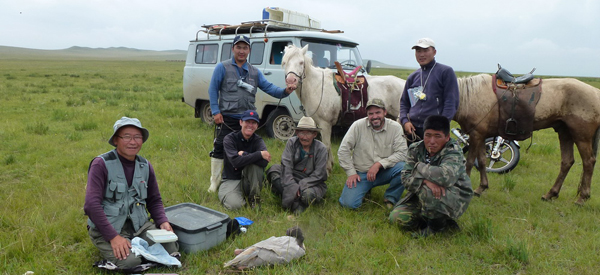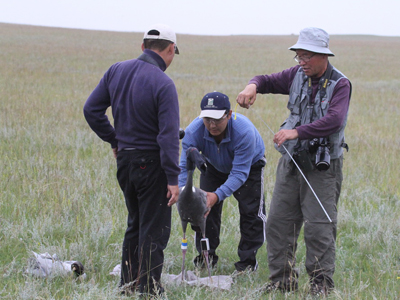
This fall, an international team of conservationists and scientists from Mongolia, China, and the United States are tracking
White-naped Cranes in East Asia to identify and protect the threatened cranes’ key breeding, migratory, and wintering habitat. Above, project staff work with local guides to locate and band cranes on the Mongolian steppes.
By Claire Mirande, ICF Senior Director of Conservation Networking, and Nyambayar Batbayar, Director, Wildlife Science and Conservation Center of Mongolia
Project Background
White-naped Cranes are only found in East Asia, and primarily nest in wetlands of the grassland and forest steppe zones in northeast Mongolia, southeastern Russia, and northeast China (learn about ICF’s work in the Amur-Heilong River basin). The cranes in the western part of the range migrate to Poyang Lake in the Yangtze river basin of southern China (the only wintering area for the species in China), while cranes in the eastern part of the range migrate to a few locations along the border area in the De-militarized Zone between North and South Korea, and to Izumi in southern Japan.
The western population of White-naped Cranes has declined from about 3,000 individuals 15 years ago to 1,000-1,500 today. Reasons for the decline relate to human activities and natural causes. The loss of wetlands and habitat degradation due to agricultural land expansion, changes in land use practices, and impacts from hydroelectric dams, both at wintering and breeding grounds, are the most significant threats. Because of their migratory behavior and unique locations of their breeding and wintering grounds, White-naped Cranes are extremely vulnerable to various threats throughout their flyways, which lie along one of the most rapidly changing regions on Earth – East China.
Identifying migration routes between breeding sites in Mongolia and wintering sites in China is critical to understand the cranes’ dispersal, migration timing, and to identify stop-over sites used by White-naped Cranes. Thus, this migration study, which employs the latest satellite and cellular tracking technology, is essential to understanding the species’ migration ecology and to develop conservation strategies for this declining population.
The species’ wintering area in China, Poyang Lake, has been under tremendous pressure from development, especially from water projects along upper streams and the Yangtze River. There have been no special studies for this species at Poyang Lake, and this project will improve knowledge of the cranes’ winter movements and habitat use, raise awareness about the status of the species, and promote needed scientific research and conservation actions by local and national governments.

Project Activities:
White-naped Crane Banding | Summer 2013
In May-August 2013, Dr. Tseveenmyadag Natsagdorj and Iderbat Damba from the Mongolian Academy of Sciences, along with Baatarkhuu Batmunkh and five colleagues from the Wildlife Science and Conservation Center of Mongolia (WSCC) roamed the vast grasslands of northeast Mongolia searching for White-naped Crane nests. Their searches focused on the Khurkh and Khuiten River Valleys in northeast Mongolia that are designated as Ramsar Sites, Important Bird Areas, and Northeast Asian Crane Network Sites. In August, the team was joined by Nyambayar Batbayar (Director WSCC), Dr. George Archibald (ICF Co-founder), and three specialists from the U.S. Forest Service (Ornithologist Robert Skorkowsky; Hydrologist Liz Schnackenberg; and Project Administrator Jennifer Smith).
With two people observing the cranes through telescopes and communicating by walkie-talkies, researchers on the ground were able to capture both chicks and flightless adults. Forty-one cranes were color banded with snap-on bands donated by Crane Conservation Germany. Six birds (4 adults and 2 juveniles) were marked with tracking devices (3 satellite transmitters and 3 cell phone trackers specially designed for cranes and this study).
Currently, the banded White-naped Cranes are increasing their movements within Mongolia, and the first birds started their autumn migration on October 4th (two of the tracked birds are north of Beijing, China and one bird remains in Mongolia)!
During the migration, project colleagues from Beijing Forestry University and Poyang Lake National Nature Reserve in China will visit stop-over sites used by the cranes, and will study the cranes’ winter movements at Poyang Lake. The Chinese researchers will be joined by Mongolian project staff in January 2014 for continuing research and discussion of project results.
